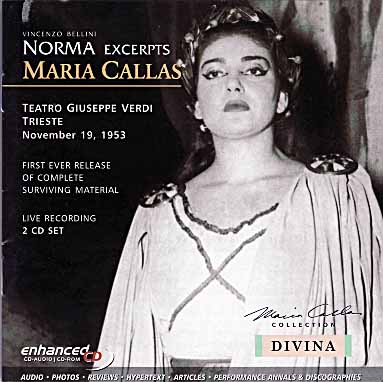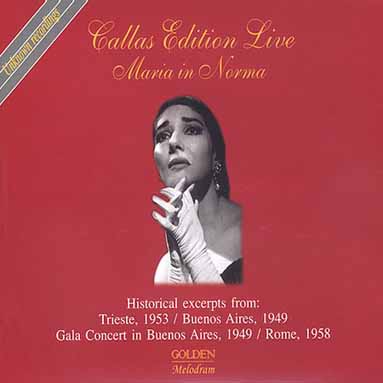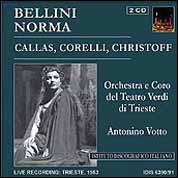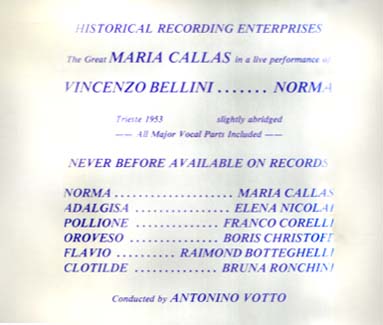The "lost" 1953 "Meco all'altar di Venere" ! | A sensational find?
|
Composer: Vincenzo Bellini Opera: Norma (complete surviving excerpts) Performers: Norma Maria Callas Chorus and orchestra of the Teatro Giuseppe Verdi, Trieste Compared with: MELODRAM CDM 26031(2 CD):
GOLDEN MELODRAM eventually released the excerpts as such on a 3 CD box set that contained different Callas Norma performances from 1949 – 1958 (GOLDEN MELODRAM GM2.0040):
Istituto Discografico released their own version both as an independant release (IDIS 6390/91) and as part of a 10 CD box, titled Maria Callas Gli Anni D'Oro (IDI 6449) We didn't yet hear either one of these releases, and we don't know from which source they copied. Until we are able to provide you with our own evaluation, here is what online critic Robert Levine wrote of the IDI release: "The sound is terrible and occasionally a few measures of music are missing; but the voices come through. You'll know if you need this."
And finally, the key to this mystery, the 1979 Historical Recording Enterprises LP release HRE 283–2, which is the source for Divina Records CD release of the missing "Meco all'altar di Venere... me protegge, me difende":
|
With Corelli's "Meco all'altar di Venere... Me protegge, me difende" from the 1953 Trieste Norma, Divina Records seems to have given us an incredible Corelli–find, although, in more than one way, it is not really a "novelty." Pablo Berruti, the owner of Divina Records, obtained the track in 2002, and published it in 2003 (DVN–3, 2003), in an upgrade to his previous Trieste Norma release (DVN–3, 2000). Inexplicably, he then "concealed" it from us by not making the scoop public. But... there is more to this story. At this point, I must take two steps back due to the continuing confusion surrounding this 1953 Corelli–Callas (sorry Pablo...) Norma broadcast from Trieste which hasn't survived in its entirety. It was around as extended excerpts only on the very rare original HRE LP–release of 1979 (HRE 283–2), until Melodram published it as a "complete" performance in the early CD days. Then, in 2000, Milan Petkovic published his analysis of the Melodram issue, which turned out to be an amalgam; missing portions of the broadcast were "completed" with takes from at least six different Normas, different mezzos were substituted (Barbieri and Simionato for Nicolai), and even Mario Del Monaco made a brief appearance in this earliest Corelli Pollione recording to date! Unfortunately, when Divina published the extended excerpts accompanied by Petkovic's analysis, the protagonist to have suffered the most proved to be Franco Corelli as his entire entrance aria and cabaletta "Meco all'altar di Venere... Me protegge me difende" were missing. And for most of us in the English speaking regions of Corelliland, that was the end of it. Speaking for myself, the 2003 Divina Records upgrade had completely eluded me, and it hadn't reached any of my Corelli friends in Europe or America, all of whom responded with disbelief when I asked them about it. In Italy and Germany, things were actually far worse, as a number of my friends (including the Corelli family) weren't even aware of the Melodram amalgam, and thought this recording to be complete as issued. A new "Meco all'altar di Venere"?After Prince of Tenors was published, Frank Hamilton asked me whether I had doubts that the Divina Records "Meco all'altar" from the 1953 Trieste performance was genuine, because Prince of Tenors still listed it as missing. I answered that I had the Divina Records issue, but there was no "Meco all'altar" there. Then he told me that, around 2002, Berruti was approached by someone who drove him a hard bargain over the missing Corelli aria, which Berruti then inserted without fanfare in to the previously mentioned upgrade. I immediately contacted my collaborators, all of whom nearly laughed in my face and said it was probably another hoax. To add to the confusion, the Divina Records website didn't mention the new addition to the performance and still featured Petkovic's article from 2000, in which the aria is said to be missing. Afraid that Frank was pulling my leg, I went to the source and contacted Berruti, who responded rather casually , as if it was but a trivial matter, that yes, he had published an upgrade with the original "Meco all'altar" restored. Trivial, of course – to a Callasite! But a Corellian would treat it as a precious gem, given the early date and the scarcity of preserved material available from Franco's earliest years. The main question: was it genuine? And who might have that old Historical Recording Enterprises LP release HRE 283–2, that I had never been able to find? An old recording in a new box...I forwarded the aria to Bruce Badger and some other members of the Prince of Tenors team so that they could compare it with Corelli's 1958 Act 1 recording with Callas, the second one of that series with Cerquetti, and also the 1971 recording with our honorary member Cristina Deutekom. I myself had had great difficulty finding significant differences at first when doing my own comparison, although the end of the aria was clearly different from all the others in that the applause started before the music had ended. But that is something that could easily be mixed in, which could also be said of the appoggiatura "Ahaaa," before the final "l'empio altar, abaaateroooooo" (he sings the supporting note in 1971, and splicing that in with todays mixing programs would take me about a minute). The missing 'b" in that same final "aBatterooooo" (in 1953 he sings "ahAteroooo") could, in theory, have been spliced out. But Bruce Badger – the most skeptical one from the start – didn't hesitate and gave me a detailed analysis which confirmed some of my points in favor of calling this aria genuine: Corelli has a significant sense of shortness of breath here, especially in the beginning where he cuts phrases just a wee bit shorter than in the later renditions (which is in line with newspaper reviews of Corelli's demeriti at the time). Badger also argued that the tempo was slower, and that Corelli attacks the start of phrases a bit more timidly than he would do later , adding that: "Corelli's vibrato here is pretty fast, early 1950s rather than late 1950s, and the top is less connected to the middle voice. It still has that wild, bright sound in it, rather than the darker, more equalized high notes he has later." These traits suggest that this is clearly the tenor's younger voice, consistent with the timbre in the rest of the Trieste recording. Not all those that I asked were sure whether two of the Flavios were different (1953 has Raimondo Botteghelli, 1958 Piero de Palma, and I found it very hard to distinguis h them myself from that short fragment); Badger, however, mentioned that the trouble with comparing these two singers is that this role is always cast with the same type of tenor voice, adding that the two Flavios did not sound like the same singer to him: "De Palma sounds smoother with better legato and a smoother passaggio. De Palma's attacks at the start of each phrase are more elegant, while the other singer's are more aggressive, bordering on frantic." *** That was the news, until, on April 13, 2008, Badger mailed me that he had gotten hold of a copy of the old HRE LP release, which boasted to have the performance: "Slightly Abridged – –All Major Vocal Parts Included – –" And... it did! The HRE LP release is the direct source for Divina Records's "new" "Meco all'altar di Venere... Me protegge, me difende..." Incredible as it may sound, no one before, including Petkovic, seems to have looked into this LP release, once the Melodram amalgam became suspect. Even more bizar is the fact that the person who put that forged complete recording together, didn't use the aria from the LP, which to a large extent must have served as the basis for that very same Melodram reconstruction. The editor either must have thought that Corelli's 1958 track was better, or that putting two different Flavios in at the beginning (the LP-set has the Pollione–Flavio recitative section "Svanir le voce" missing) would be too obvious. And so, the Divina Records release remains a first on CD, but it is not a genuine world premiere or a new discovery. |
THE ORIGINAL "MECO ALL'ALTAR DI VENERE" IN PERSPECTIVE
What strikes one immediately when listening to this new "Meco all altar di Venere... Me protegge , me difende," is this Pollione's impressive ring & ping. Yes, Corelli is not as complete or as subtle as in his golden years, but in those phrases where he can make an effect ("...tu l'adorata vergine, dio") he exhibits an unfailing ability to create excitement. There is no High C here (nor is it there in 1958 or 1971 – Corelli only observed this written High C in his two studio recordings of "Meco all'altar"), but his style is straightforward, emotionally charged and already rich in punctuations and accents, embedded appropriately in the text rather than tied to the music alone. Observe the rolling "Rs" in "altar," "fior," "amor," the emphasis on "folgore," and "trovo", but also the sacrifice of a few less successfully sculpted phrases such as "Misto de' figli al pianto...," where he has to catch his breath a little too loudly before attacking "pianto." This leads to a slight shortness of breath forcing him to adopt a sketchy approach in "Ed una voce orribile, eccheggia in fondo al tempio," which is sung with less color and richness of tone.
With his vibrant, young voice he sounds less bull-like than later on, more like a young than a middle aged proconsul. Rather surprisingly, his phrasing for this role was almost completed by 1953; all subsequent versions show very little deviation from this one. Already a marvel of sculpted legato singing, this Trieste version boasts little arcs that reside within a greater arc, leading to the dramatic climax. Stunning effects, especially considering that he had been singing professionally for only two years here, and it serves to demonstrate how seriously he took his work, how he went at new roles with such determination. This was not a singer merely out to get through a performance, but rather a tenor determined to convince and to hold his own among a team of unique singing actors – the very best of his day. That determination, combined with a natural talent, eventually would enable him arguably to surpass each and every one of his rivals.
VOICES IN COMPARISON – POLLIONE
In short, this is a quintessential aria in the Corelli literature, fully matching the contemporary rave reviews of his Pollione which, by then, despite a few shortcomings, was already being judged unsurpassable. And to whom could he be compared here, in this Domenico Donzelli part? Norma was not that frequently performed in the first half of the century. Giacomo Lauri-Volpi left a fine 1928 recording of the aria which was made in his prime, but he lacks the dark hue that Corelli brings to this part. Aureliano Pertile sang Pollione three times, but left no recorded mementos of his rendition of the role. Giovanni Martinelli is a fine Pollione next to Gina Cigna, but that recording suffers from primitive recording conditions. Mario Del Monaco, a splendid Pollione, sang the role even more infrequently as Corelli, and he started his venture into Belliniland only two years after Corelli first took on the role. However, singing is not necessarily equal to sport; one can appreciate either singers's approach to the drama. Del Monaco brings out the brutal characteristics of Pollione, as Felice Romani painted him in the libretto. Corelli, in turn, makes you forget those characteristics, winning you over to the more noble side of the male protagonist from the start. His is a tragic Pollione, rather than a self indulgent heroic one. One tenor should be mentione dhere as well: Kurt Baum, the only tenor of that era that included the High C in the opening aria in a live performance that was preserved in a recording (the 1950 Callas Norma from Mexico). However, apart from that brilliant note, he hardly seems to have an idea of what he singing.
VOICES IN COMPARISON – OROVESO
As Oroveso, Boris Christoff has hardly any competition on recordings – not even in name, at any time in history, except for his contemporary Cesare Siepi, who sang the role in three runs at the Metropolitan Opera, in 1954, 1956, and 1970. Christoff's single recorded Oroveso is to be found in this Trieste broadcast performance, and he defines the role; bold, heroic, with a timbre that lends the required grandeur, and with an impetuous self–assuredness that makes you feel that Bellini couldn't possibly have thought that a singer would ever reach such depths in the part.
VOICES IN COMPARISON – NORMA
We do not know the voices of Giuditta Pasta and Maria Malibran, but we do know those of Lilli Lehman and Rosa Ponselle. Perhaps the comparison with Lehman is not altogether fair, as she recorded late in life and her efforts were limited by the inferior recording technique of her time – comparing Lehman's voice to Callas's here would be as unfair as comparing Callas in 1973 with the Callas from 1953. Of Ponselle we have the reviews and a few exemplary studio recordings of arias and duets. As for Callas, it is very interesting to hear her sing "Casta diva" in the higher key of G (usually she sang the lower adaptation Bellini composed for Giuditta Pasta, who shunned the original key, that was then restored by Maria Malibran.) Callas repeated the experiment with the key of G only once thereafter, in London the following year, and especially in sections like the high coloratura notes on "A noi volgi il bel sembiante," and in the variations, here and on "Spargi in terra quella pace Che regnar...," the higher key clearly adds a brilliance that Callas fully exploited. On the other hand, I find her less velvety, singing with less richness of tone in the middle section. Actually, it makes you understand comments by a contemporary critic, G. Pan., who thought her approach to be too brutal. Listening to the cabaletta, I cannot wholly disagree with him, although I don't necessarily regret this female shark's approach to the top notes which she takes with gusto, much as one expects Jaws to cut through flesh and bones.
VOICES IN COMPARISON – ADALGISA
The Bulgarian mezzo Elena Nicolai (1905-1993) was then a grand old lady among mezzos; impressive, but also very inappropriate for the young Adalgisa. Nicolai compensates for her very mature voice with some powerful final phrases, but she can't make one forget the odd vocal distribution here which, by convention, calls rather for a soprano–like Adalgisa and a mezzo–like Norma. On balance, Giulietta Simionato's vocally fresh approach with her falcon voice type is probably the one to be preferred during this period; among Nicolai's contemporaries, Ebe Stignani (1903–1974) made Adalgisa her signature role. Stignani not only had the advantage of being Italian by birth, she also succeeded a little better in hiding her age than Nicolai does here.
ACT I CONTINUED
Corelli's singing in the duet "Va crudele... Vieni a me..." makes it clear why some fans prefer his earliest recordings where he sang as though the devil was at his heels, with that flicker vibrato which fit so well with restless tenor parts such as this baritonal one. And this is not just engaging in muscular singing anymore – he imbues his lines with tenderness, despair and all the mixed emotions that are contained in the music. Note especially his fine mezza voce effects on "O mia diletta! il Dio Che invocar devi, e Amore..."
The trio "Oh, di qual sei tu vittima" is consistent with all that has been said before: Callas is thrilling but not as multifaceted as in her later years, Corelli answers her fittingly in "Norma! de' tuoi rimproveri," with his soaring, sumptuous tone, heroic, ringing, and yet still vulnerable – a hero destined to lose. Nicolai sounds a little too old, but that doesn't stop the trio finale from being a Grand Opera thriller in the old fashioned style, with Corelli briefly drowning out Callas in a vocal minibattle, although he quickly regains his vocal manners and backs off.
AFTER THE BREAK
Act II has Callas emerging from the interval with newfound colors on her palet te; she is decidedly more introspective, with more of that black velvet on her voice, and a tragic pathos. Once we come to the "Mira o Norma," Nicolai rises to her moment of glory, for which she lightens her voice decidedly. Yet, Callas easily dominates the duet, her voice growing ever richer in shades and her top on this evening was truly better than ever before or after – a laser beam!
Corelli has to wait his turn here, which arrives with "No: si vil non sono." He sounds luscious, round, warm, and baritonal, matching and echoing Callas's approach in "In mia man, alfin tu sei." Curiously, some contemporary reviews still mentioned that he had yet to learn a thing or two about refined singing, but in this duet he would never surpass himself again. Singing as he did here is what landed him La Scala, and it is also what made people line up for days to get tickets to Corelli performances – as early as 1953. Callas has no choice but to progress to yet another level of performing, which culminates in her rendition of "Adalgisa fia punita; Nelle fiamme perira." This is the vocal Mount Olymp us, with Callas as torchbearer, a vocal actress beyond compare. Admittedly, she has the best part here; she can revel in anger, whereas Pollione must plead. He states his case marvelously in the "Ah! t'appaghi il mio terrore" section, but even so, he must bow before this unchained Norma; singing like Callas's singing here was at the time beyond his powers, perhaps beyond anyone's powers.
As for the finale, just listen to Corelli's phrasing in "Non le credete," and then to Callas's unique, dramatically charged approach to "Qual cor tradisti." I love her more intense interpretations in later years , but wouldn't miss this one for the world. Her "Crudel romano, tu sei con me" has bite and her final diminuendo is ravishing, indeed it is her most beautiful note in the performance. It forces Corelli to surpass himself once again, which he does in "Ah! troppo tardi t'ho conosciuta." Where Callas tries to challenge him with impressive, piercing notes, he answers with a balanced, sculpted, highly intelligent interpretation of this crucial section. An operatic thriller! Thanks also to Antonino Votto, whom I must once more defend against his more famous contemporary Tulio Serafin. I like Votto, here as well as in general, because he perfectly blends both his function as a singer's accompanist and as a blood & gut conductor in instrumental passages such as Bellini provided in abundance. I find Votto much more imbued with passion than Serafin, who usually strikes me as the more tame one of the two. In Votto, I can easily hear the hand of Toscanini.
ON THE TECHNICAL SIDE
For 1953 standards, especially given the history of this broadcast recording which has survived only in bits and pieces, the sound quality is rather good. Occasionally one can hear differences between sections deriving from different sources, there's also just a bit of shrillness on the soprano top notes, which slightly seems to affect Callas's timbre there, but this never really disturbs the performance, which I find enjoyable throughout.
EXTRAS
As usual, Divina gives us an enhanced CD. It includes Milan Petkovic's dissertation on the ins and outs of the Trieste Norma recording, and it also features Frank Hamilton's Maria Callas performance annals, a few contemporary performance reviews (translated into English), the original program booklet in facsimile and six photographs from the performance. The CD booklet features a detailed and, in my view, fine analysis of Callas's singing in this recording. In short, this is absolutely an excellent example of how historical CDs of live rcordings should be produced! – BB & RS.








